PEADAR LAMB
Case Study - Irish Repertory Theatre, New York
In this case study the commission was for the façade of the Irish Repertory Theatre in Manhattan, New York. I visited the site first in the summer of 2007. The finished work was installed In November 2009.
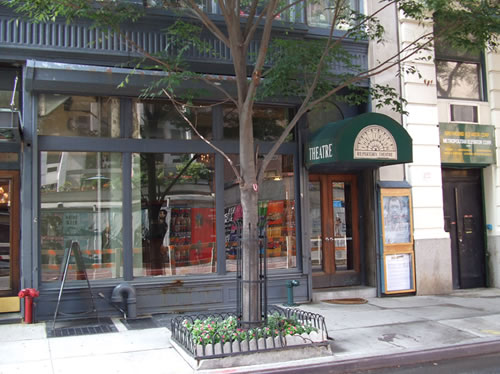
Site visit
In 2007 I visited the Theatre to discuss with the Directors the content of the 100 square foot stained glass panels that would become part of the Theatre’s façade. I also had to consider the Theatre’s orientation and quality of natural daylight available. The quality of light varies greatly depending on whether it is north or south facing and in this case the light is further affected by the high rise buildings Manhattan is famous for.
Research
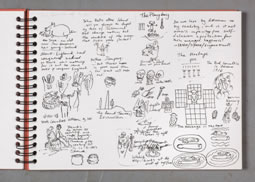
After the initial meetings with the directors it was decided that the commission would be based on the writings of Irish and Irish American playwrights, the commissioners in understanding the creative process, left it to me to decide the final imagery.
Back in the studio in Ireland I spent the next 2months reading and researching. Initially this research involved reading a number of plays and taking written notes on what suggested a strong visual image, then I reread my notes and sections of plays, which began to take the form of sketches and drawings. I tried to capture some aspect of the play that had some visual resonance for me.
Early Concept Drawing
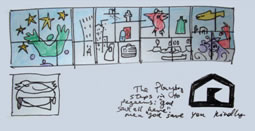
After a time I tried to make sense of the imagery/research I had been gathering to bring it all together to form a coherent composition that would make some sense of the project to me.
Final Concept Drawing

Late in the winter of 2007 I finished the final concept drawing. This charcoal drawing had something of the quality I was trying to achieve. Though the finished piece would be in colour I decided to present the idea in monochrome so the directors could see the content and concept of the work and not to be swayed by the introduction of colour; to see the piece for what it was. This approach has become a regular part of my practice. Sometimes I do introduce colour to the concept drawing, though more as a guideline as more often than not the finished piece will be quite different. The work gains clarity at the various stages as a deeper understanding develops.
There were many ideas that had a strong visual quality to them but I decided not to use them in this context, so I had to edit. I photographed the final drawing; emailed it to New York, an hour later I was speaking to the Directors explaining the concept drawing. They were delighted and moved. I was given the go-ahead.
Early Working Drawing
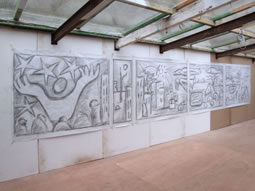
In early 2008, I began to work on the piece to full scale. At this stage and at this scale you start to see what’s working, you also see the inherent movement within the composition and where perhaps the emphasis needs to be pushed or pulled.
Studio Interior Working Drawings

After the content and composition had been decided on, (though changes would still occur), the colour studies began. The colour and the glass chosen greatly affects the composition further. For example using a (red) colour across the piece from left to right can unify, create movement and bring the viewer across the composition, this often happens without the awareness of the viewer.
Colour study

When all the glass is cut it is placed up on the easel against daylight to see if any colour changes are needed. This extra process adds more time to the project, yet it is important, as what may seem to work on paper may not always work in glass against daylight.
Painted Glass on Easel

I paint and fire the glass a number of times. The first stage involves painting all the line work, this is known as the ’trace line’. Each painted piece is then fired in a kiln, which fixes the paint permanently to the glass.
Applying Painted Glass to Easel
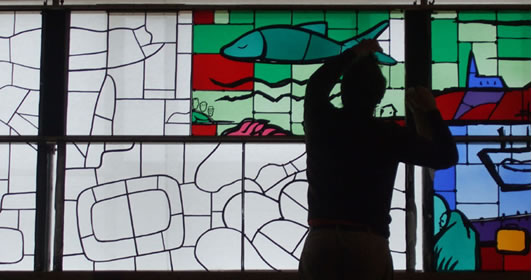
This fired glass is then placed on the easel against daylight. In my practice the importance of placing the glass against daylight cannot be underestimated. Daylight’s strength, compared to artificial light, will burn out any weak painting.
Painted Glass on Easel
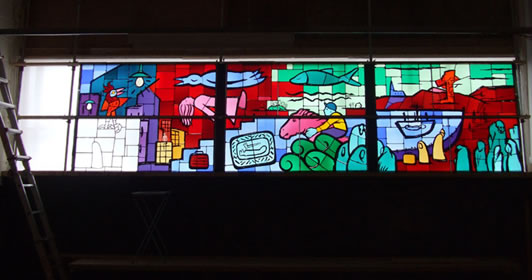
Installing the glass vertically on the easel is time-consuming, but the benefits to the finished work far out-weigh the extra time taken.
Next I cover the surface of the glass with paint to obscure the light from passing through. Then I start to lift the paint off the surface to let in the light. I work over the whole area of painted glass, controlling the balance between light and dark.
Final Stage Painting on Easel
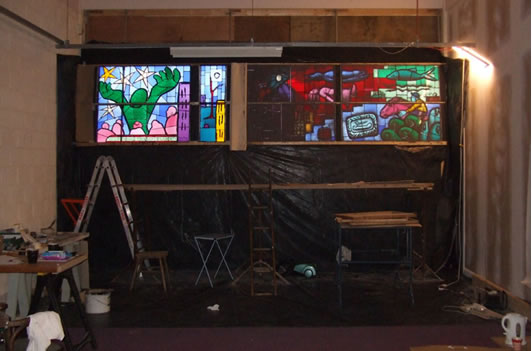
Because of the scale of the piece it was important to step back from it and not overwork an area. This was also important because the finished piece would be viewed from a distance.
Leading the Fired Glass
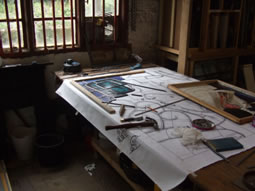
When all the painting was completed and the glass fired each panel was leaded together. This piece was made up of 18 leaded sections, due to the large scale.
Installation New York 2009

A large stained glass piece is often made in sections for ease of construction/leading, to safely transport the work and also for ease of installation.
In Situ detail New York
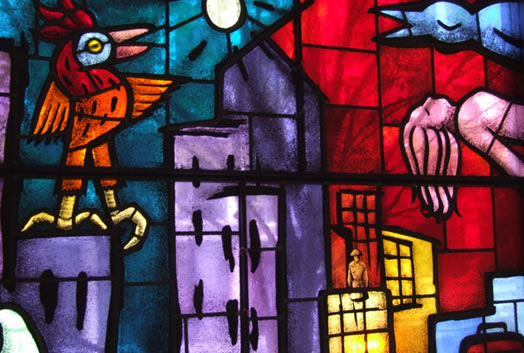
This detail shows the quality of light and the interaction between the work and the dappled light beyond, with daylight the quality of light is constantly changing. This changing light further enhances and brings life to the finished piece.
Completed Stained Glass panels

The completed work is shown here as a continuous piece rather than including the building’s façade as below.
Irish Repertory Theatre New York Exterior November 2009
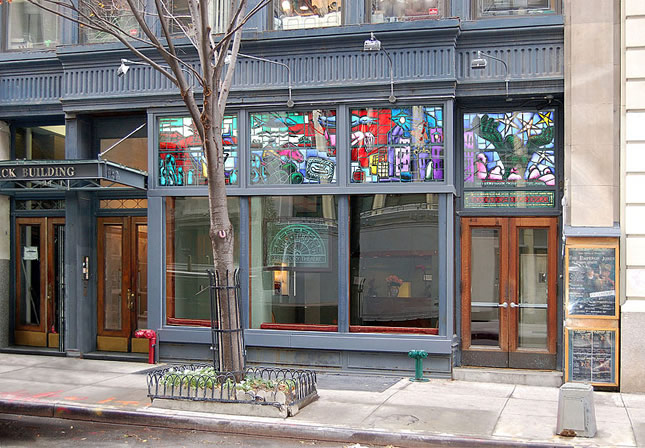
To the credit of the Theatre directors/commissioners they had an understanding of the creative process, so I was given the freedom the project needed. From the initial concept drawing back in 2007 to the installation in November 2009 it was a very successful relationship and was received very well.